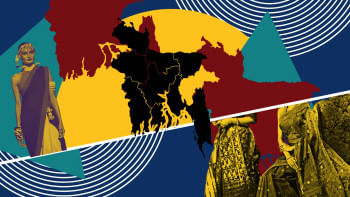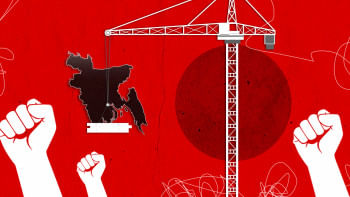Nation branding can bring out Bangladesh's global potential

In today's globalised world, country brands tell a powerful story, in a minimal gesture, to promote a unique positive image of a country to achieve certain beneficial goals. It is a comprehensive undertaking to represent an appropriate national identity that conveys distinct economic, cultural and social features of a country to the broader global community.
Nation branding is a multi-stakeholder undertaking across economic, social, cultural, academic, legal and political spheres. It is not an exercise of just coining a catchy phrase and a graphic image to tell a compelling story. Rather, country branding is an undertaking of elaborately scrutinising factual grounds in multiple arenas to express precisely what a country's national identity stands for, and what the attitudes and aspirations of its people are. Based on those, country branding requires appropriate regulatory framework and political steps that would convey those attributes to the broader global community.
In an interconnected and disruptive global economic landscape, Bangladesh needs to undertake a country branding master plan focused on national identity to promote collective self-esteem and a positive image to the outside world. A well-scrutinised country brand should carry the message of a prospective economy, resilient people ready to assimilate new ideas and skills, abundant workforce and a vast pool of talented youths. A strong country brand can give a positive signal to stimulate investor confidence. A successful country brand may become an express avenue of nation building efforts.
The economy of Bangladesh at its birth as an independent nation in 1971 was in a shattered state. An estimated 15 lakh homes had been destroyed during the Liberation War. Hundreds of thousands of people had been displaced and many farm families were reportedly left without tools or animals to work their lands. Transportation and communication systems were miserably disrupted, with roads damaged and bridges destroyed.
The economy began to gain some ground as some ready-made garments (RMG) factories were able to export apparels to certain developed countries from the mid-80s. The economic scenario changed in the mid-90s, boosted by the success of the export-oriented RMG industry. Inflow of foreign direct investment (FDI) increased, mainly in RMG alongside the power and energy sector.
With increased availability of employment opportunities, domestic consumption increased, boosting growth of various industries targeting the domestic consumer market. Remittances from migrant workers helped to reduce household poverty and became a major source of foreign exchange earnings.
Bangladesh began to show outstanding economic performance in the 2000s, with a growing domestic market and favourable access to world markets. FDI further surged in telecommunication, banking and the RMG and textile sectors.
The resilient people of Bangladesh have the determination to stand up for national aspirations and keep on struggling for material betterment. Despite political disruption from time to time, and major setbacks from natural disasters such as floods and cyclones, Bangladesh has made significant strides in economic development over the years. Significant achievements have been made in several of the human development indices. Over the decades, the country has emerged as one of the largest apparel producing countries in the world, second only to China. Plus, it has promising prospects in several sectors, including IT, semiconductor, light-engineering and others.
A good country branding strategy results in an unshakeable association with a certain identity, features and prospects. A country brand draws attention of its own citizens, foreign stakeholders and the global customers to some stimulating feature or some distinctive quality.
"Malaysia Truly Asia" is a powerful destination brand, designed primarily to attract more tourist interest. A multicultural country, Malaysia is home to people from major civilisations of Asia. "Malaysia Truly Asia" from that context is factual, convincing and unique, which strongly draws attention to the premium but affordable hospitality it offers.
"Incredible India" is an international tourism campaign launched by the country's government to promote tourism. By drawing attention to the unique history and culture, such as yoga and spirituality, the "Incredible India" campaign has successfully positioned India as the fastest-growing market in the Asia-Pacific region, in terms of international tourist spending.
However, it is to be noted that the scope of nation branding goes beyond the tourist campaign. The example of Singapore demonstrates the success of a long term and clear plan in nation branding. "Passion Made Possible" is the destination brand of Singapore, launched in 2017. The brand draws attention to a shift from an investment-driven economy to an economy led by innovation. Singapore has established itself as a leading regional hub in high-growth areas such as financial services, technology and sustainability through targeted investments and its brand campaign.
Investors usually assess an investment destination in terms of consistency in policy framework, political stability, productivity and sustainability. Bangladesh has exhibited economic resilience and dynamism amid global crises such as Covid pandemic and the war in Ukraine. On the cultural stage, the country has a strong heritage of resistance and resilience. The International Mother Language Day, celebrated worldwide, is a testimony of resistance and uprightness to stand up for people's rights. People in Bangladesh have stood up time and again to protest against oppression and injustice.
Although Bangladesh has established proficiency in high quality industrial production other than apparel, such as pharmaceuticals, footwear etc, it is still primarily perceived as a destination for cheap labour. This narrow perception has been a limiting factor for Bangladesh in terms of availing high-end production opportunities.
Rising geopolitical tension, protectionism and policy emphasis on economic resilience are realigning global supply chains. At the same time social and environmental concerns are redefining consumer preference. A growing majority of young consumers are seriously concerned with social and environmental causes. They progressively back their beliefs with their consumption habits, and only favour brands that are aligned with their values.
Nation branding is a powerful strategy for harnessing untapped potentials in an interconnected disruptive economic landscape. A well-focused nation branding strategy has to take into consideration the size of the country, geographic location, economic resources, domestic history and culture as well as historic global role.
A strong country brand also has to reflect the identity of its people, history, heritage, culture, values, actions and behaviours that influence the perception of international stakeholders, and thus the way they engage with the country.
T.I.M. Nurul Kabir, a business, technology and policy analyst, is executive director at Foreign Investors Chamber of Commerce and Industries (FICCI). He can be reached at [email protected].
Views expressed in this article are the auhtor's own.
Follow The Daily Star Opinion on Facebook for the latest opinions, commentaries and analyses by experts and professionals. To contribute your article or letter to The Daily Star Opinion, see our guidelines for submission.

 For all latest news, follow The Daily Star's Google News channel.
For all latest news, follow The Daily Star's Google News channel. 








Comments